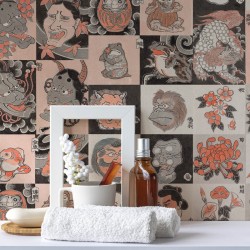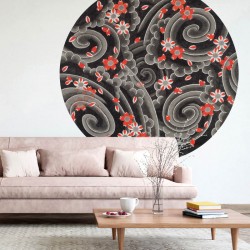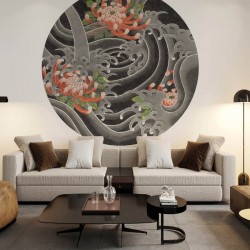Gakubori is the forms of background in traditional Japanese tattoo. Gakubori compliments the main theme by expressing the world around it. This is achieved by adding backgrounds such as clouds, waves, and flowers. It has the effect of making the main theme stand out in the same way as framing a painting. The Literal translation of Gaku 額 is "framed", Bori 彫り is "tattoo". Gakubori has specific shapes and formulas. Only the arms and back piece are possible to arrange independently with Gakubori. The abdomen and legs are assumed to be connected to them and they alone by themselves can not be completed with Gakubori. The abdomen is added together with the legs after the arms and back are finished.
- Specifications
Premium quality heavy duty 160 grs wallpaper with paper top layer and non woven backing; Colourfast and washable with a soft cloth; No wallpapering table necessary, glue is applied to wall; Fire rating USA ASTM E 84.10 EU B.s1, do.
- Size Description
EU Roll size: W 48,7 cm x L 1000 cm = 4,87 m2
US Roll size: W 19,2" x L 393,7" = 52,42 SqFt
No match, repeat 414cm (163")
-
Kensho II
<p>Kensho Ⅱ is a Japanese tattoo master using traditional “Tebori” methods and “Sashibo”instruments. He began apprenticeship with his master Takehisa Muramatsu in 2000. Asked by Takehisa Muramatsu if he would one day like to become a tattoo artist Kesho answered “yes Sensei!” From that point his tattooing career took off. It's very difficult to be given the chance to become a tattoo apprentice in Japan, especially within a traditional Japanese tattoo family.</p> <p>The Japanese apprentice system is very strict. Takehisa Muramatsu never taught Kensho directly - Instead, he watched his technique and studied his drawings for couple years until he received permission to practice Sashibo and Tebori - but not on customers. He trained on various items such as paper, radish, banana, pig skin bought in a supermarket etc. After much practice he ultimately tried the techniques on his own skin and studied what sort of ink mixtures (Japanese traditional tattoo artists make black ink for each appointment) worked and looked better, how much force he should apply for Tebori, etc...</p>


 EUR
EUR























